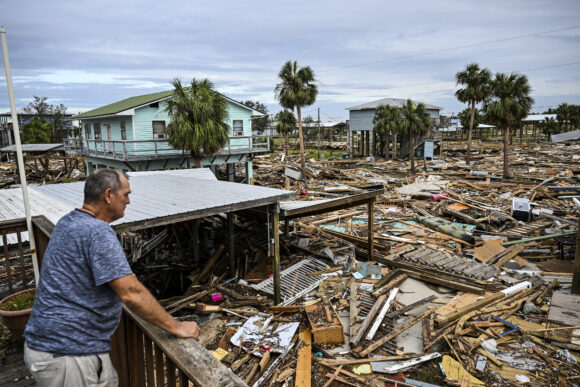Hurricane Helene has halted chicken processing plants and caused severe damage to some flocks, while also downing pecan trees and flattening cotton crops, as floodwaters swamped the southern U.S.
Every commodity was impacted, with cotton, pecans, poultry and timber the hardest hit, according to Matthew Agvest, communications director for the Georgia Department of Agriculture. While it’s still early in the assessment stage, the state expects Helene to be more costly than Hurricane Michael in 2018, which caused $2.5 billion in agricultural damage.
“The future of hundreds of agricultural operations across Georgia is uncertain,” the state’s Agriculture Commissioner Tyler Harper said in a letter to Georgia’s Congressional Delegation. The storm “could not have come at a worse time for our farmers and producers, who are already faced with record-setting drops in net farm income caused by inflation, high input costs, labor shortages, global competition and low commodity prices.”
Related: AccuWeather Puts Total Damage and Economic Loss From Helene at $145B to $160B
Helene crashed into Florida’s coast as a Category 4 hurricane before making its way inland. The giant storm with 140-mile-per-hour winds killed more than 90 people, knocked out power for millions and drenched states including Georgia, South and North Carolina.
Wayne-Sanderson Farms’ poultry processing facility in Moultrie, Georgia, will not operate any shifts on Monday, according to a post on the company’s Instagram account. Operations at two chicken plants run by Pilgrim’s Pride Corp. were suspended on Saturday due to power outages, owner JBS SA said in a statement to Bloomberg.
Damage caused by the powerful storm has the potential to further constrain poultry production growth in the US at a time when demand is surging. Georgia and North Carolina are among the largest US chicken producing states.
Related: Helene Unleashes Floods and Knocks out Power to Millions
On Saturday, Georgia governor Brian Kemp said in a press conference that 107 poultry facilities had been “damaged or totally destroyed by the storm.”
Nikki Richardson, a spokeswoman for JBS, said the company was still examining the extension of the impact to growers. “We know many birds have been lost in some areas and the damage to some farms has been severe,” she said.
Cotton producers were also hit, with growers affected reporting yield losses from 35% to a total crop loss, the Georgia Cotton Commission said on its Facebook page. “Losses will extend well beyond the farm, as cotton gins, other agribusinesses, and rural communities will feel the ripples of Hurricane Helene’s aftermath for years to come,” the group said.
Related: Hurricane Helene to Hit as Cat 3, and Early Estimates Forecast $3-$6B in Insured Losses
Cotton futures gained as much as 1.4%, the only soft commodity that was up as of 10:50 a.m. Monday in New York.
Most of the hurricane damage occurred in the eastern portion of Georgia, sparing higher-producing counties in Southwest Georgia and Southeast Alabama, said Walter Kunisch, a senior commodities market strategist at Hilltop Securities. Cotton production in the state will decline, but the extent of that loss is still unclear, he added.
“The path of the storm saved the cotton in those regions, but where the losses in cotton occurred, the damage was severe and resulted in total losses,” Kunisch said.
Top photo: Damages after Hurricane Helene made landfall in Horseshoe Beach, Florida, on Sept. 28. Photographer: Chandan Khanna/AFP/Getty Images.
Was this article valuable?
Here are more articles you may enjoy.


 Rare Weather Warning Issued as Strong Gusts Fuel Colorado Wildfire Threats
Rare Weather Warning Issued as Strong Gusts Fuel Colorado Wildfire Threats  Flooding in California Leads to Soaked Roads, Water Rescues and 1 Death
Flooding in California Leads to Soaked Roads, Water Rescues and 1 Death  Instacart to Pay $60 Million in FTC Consumer Protection Case
Instacart to Pay $60 Million in FTC Consumer Protection Case  Wells Fargo Sued by Ex-Manager Who Said Bank Faked Diversity
Wells Fargo Sued by Ex-Manager Who Said Bank Faked Diversity 